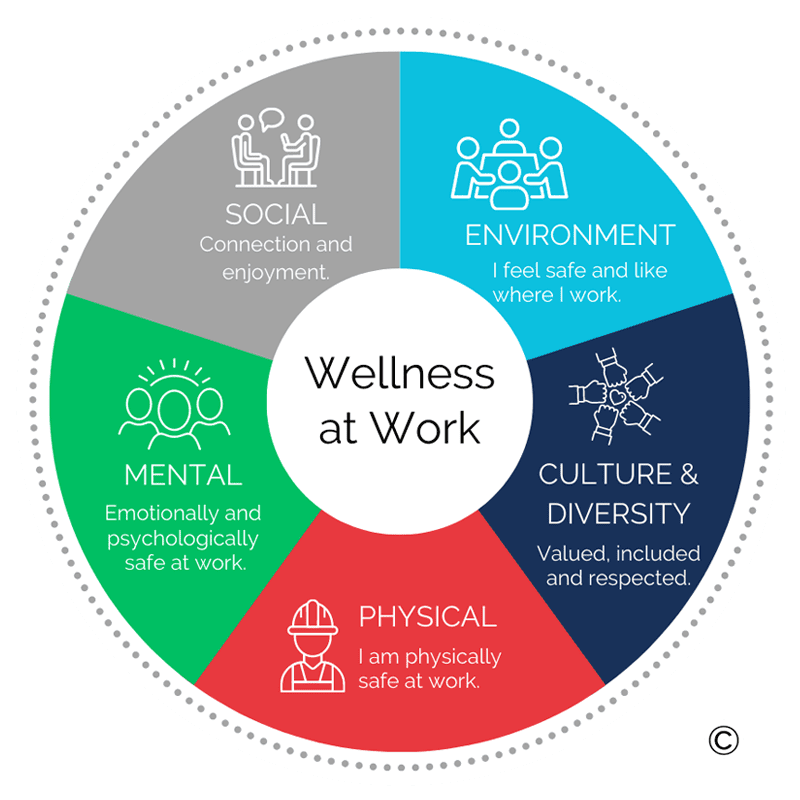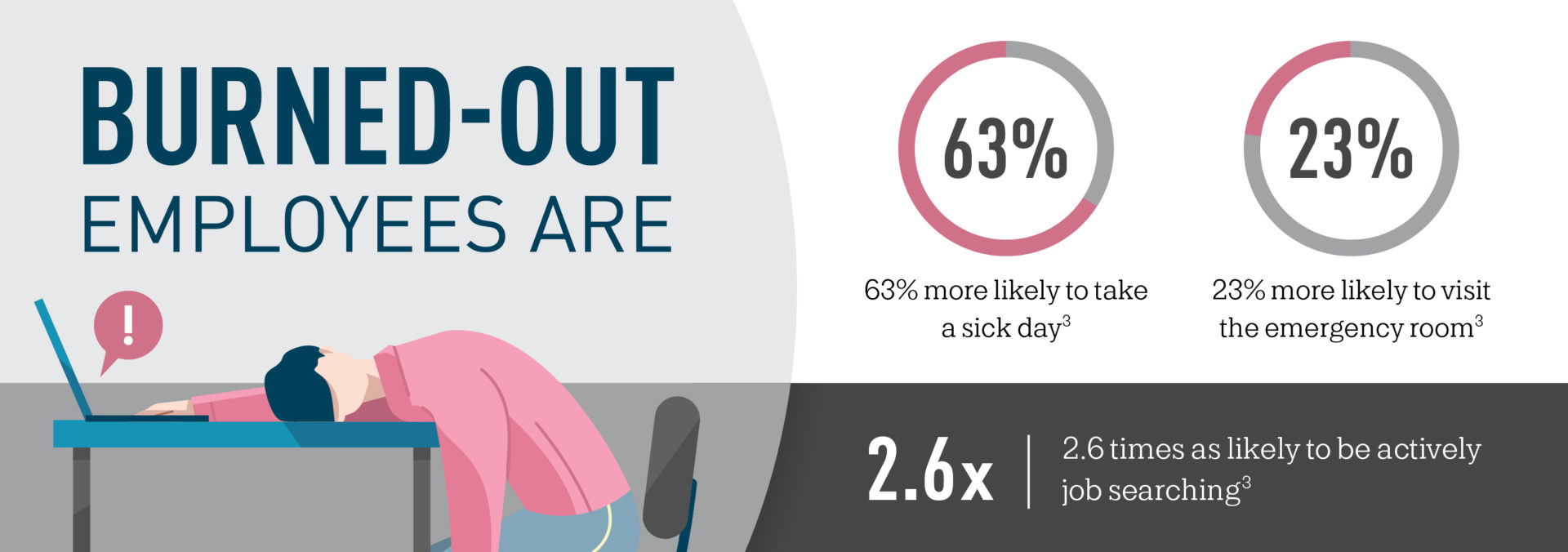- Details
- Ian McLaren
- Sales
- Hits: 665
How Fostering Employee Well-Being Can Enhance Your Sales and Marketing Results
The #1 tip for enhancing sales and marketing through employee well-being is to prioritize a positive work environment by promoting work-life balance, offering mental health support, recognizing achievements, and fostering a culture of collaboration, which enhances engagement, creativity, and overall performance.
Prioritizing employee well-being may not seem like an obvious sales and marketing strategy, but it can significantly enhance productivity, creativity, and overall performance.
A supported and valued workforce engages more positively with clients, fostering better communication, stronger relationships, and increased sales. Additionally, investing in well-being reduces turnover and strengthens team continuity, enabling long-term strategic success.
By nurturing a healthy work environment, businesses create a foundation for sustained growth and a competitive edge in the marketplace.
Click on each corresponding link to jump ahead:
1. The Link Between Well-Being and Sales Performance
2. Strategies for Promoting Employee Well-Being
3. Measuring the Impact on Sales and Marketing
4. Other Reasons Why It's Important to Promote Well-Being
If you're a small to medium-sized business looking for sales and marketing assistance, contact Profitworks today!
1. The Link Between Well-Being and Sales Performance
Employee well-being directly influences sales performance. A focus on fostering well-being can lead to increased morale, higher engagement, and lower rates of burnout and turnover.
Boosting Team Morale
When team morale is high, employees are more motivated and energetic. This creates a positive environment where each person feels valued and part of a team effort. Sales professionals who are satisfied and enthusiastic about their roles tend to be more persuasive and effective in client interactions.
Consider implementing regular team-building activities or wellness programs that encourage camaraderie. A team that enjoys their work and each other's company will likely surpass sales targets.
Regular appreciation and recognition can bolster morale further. Keep communication open and ensure everyone's voice is heard. A team that feels respected and supported is bound to be more successful.
Source: WorkTango
Enhancing Employee Engagement
Engaged employees are deeply connected to their work. They are not just present physically but emotionally and intellectually committed. This connection drives them to go the extra mile to reach sales goals.
To boost engagement, provide opportunities for professional growth and learning. Offering training and workshops helps employees feel invested in their development.
Allow some autonomy in how they achieve their targets. Encourage feedback and be open to new ideas. When employees feel they have a stake in the decision-making process, their commitment to success rises significantly.

Source: https://ldn.com.au/
Reducing Burnout and Turnover
High levels of well-being reduce stress, preventing burnout and decreasing turnover rates. Frequent burnout can hurt sales performance, causing missed opportunities and poor client interactions.
Prioritize mental health by offering resources such as counseling services or stress management workshops. Allow flexibility in work hours to accommodate personal needs. Transparency about workloads and realistic goal setting can prevent employees from feeling overwhelmed.
By actively preventing burnout, you retain talent and maintain consistent sales efforts. Lower turnover also means retaining clients who trust and prefer familiar faces, preserving and enhancing client relationships.

Source: https://www.tempworks.com/
2. Strategies for Promoting Employee Well-Being
Boosting employee well-being can create a more vibrant and productive workplace, enhancing collaboration and job satisfaction. Here are some strategies to consider.
Flexible Work Arrangements
Offering flexible work schedules can promote a healthier work-life balance. Whether it's remote work options or adjustable hours, flexibility allows employees to manage personal obligations better. This approach fosters trust and increases motivation.
A flexible work policy can encourage a sense of autonomy, which often leads to higher job satisfaction.
When employees have control over their schedules, they are more likely to approach tasks with enthusiasm. This adaptability contributes positively to mental health by reducing stress and preventing burnout.
Health and Wellness Programs
Implementing health-focused initiatives is a vital step in promoting well-being. Programs that include gym memberships, mental health days, or wellness workshops offer employees resources to stay physically and mentally fit. Access to these benefits can reduce absenteeism and increase productivity.
Encouraging participation in wellness activities, such as yoga or meditation sessions, shows a commitment to your team's health.
When employees feel supported in their personal health journeys, their engagement at work improves significantly.
Taking part in these initiatives can help you improve your well-being at work, leading to higher energy levels and better overall job satisfaction. These initiatives also promote community and camaraderie among team members, contributing to a more positive workplace environment.

Source: https://www.superbeings.ai/
Continuous Learning and Development
Investing in ongoing education opportunities keeps employees motivated and valued. Workshops, online courses, and training sessions can enrich employee skills and knowledge. This not only benefits individual growth but also enhances team performance.
Providing resources for professional development ensures employees can expand their expertise and advance their careers.
By encouraging skill-building, you create a culture of growth that aligns personal aspirations with company goals. Employees who feel they are learning and advancing are often more committed and effective in their roles.
Consider programs that align with personal career goals to foster a sense of progression and achievement. When you invest in your team's development, everyone benefits from a more dynamic and skilled workforce.
3. Measuring the Impact on Sales and Marketing
By focusing on employee well-being, you can see a significant shift in sales and marketing results. It directly influences performance metrics, enhances customer satisfaction, and elevates brand reputation.
Performance Metrics and Analytics
To truly understand the effect of employee well-being on sales and marketing, dive into performance metrics and analytics. Metrics such as conversion rates, lead times, and customer acquisition costs can offer insights into productivity and efficiency levels. Use analytics tools to compare sales data before and after implementing well-being initiatives.
This comparison often reveals trends tied to employee morale and productivity.
Surveys and reports that factor in employee satisfaction can show notable changes in overall team output. Such metrics provide a concrete basis for assessing how empowering employees translates directly into better sales figures and marketing reach.

Source: https://www.monday.com
Customer Satisfaction and Loyalty
Employee well-being directly affects how your customers perceive and interact with your brand. Happy employees often lead to happier customers. This relationship can be measured through increased customer satisfaction scores and loyalty indexes.
When employees feel valued and engaged, they tend to provide exceptional service, contributing to positive customer experiences. This can boost repeat business and increase referrals, which are invaluable for growth. Surveys, feedback forms, and customer reviews often reflect this positive impact, showcasing a correlation between well-being and customer retention rates.
Source: https://6sense.com/
Brand Reputation and Positioning
Well-being fosters a positive internal culture that spills over into how your brand is perceived externally. A company that invests in its people earns a reputation for being ethical and socially responsible. Track this through online brand sentiment analysis and social media monitoring.
By ensuring your team is content, you're likely to see improved brand positioning in your market. A strong internal culture often attracts positive media attention and public interest. This increased visibility can enhance your brand's reputation and open doors for partnerships and expansions.
Prioritizing employee well-being is not just an ethical consideration—it is a strategic advantage that directly impacts sales, marketing performance, and overall business success. A motivated, engaged, and healthy workforce fosters stronger client relationships, enhances productivity, and sustains long-term growth.
Source: https://www.groupcaliber.com/
4. Other Reasons Why It's Important to Promote Well-Being
Promoting employee well-being is essential not only for enhancing sales and marketing outcomes but also for fostering a thriving organizational environment. When employees feel valued and supported, they are more likely to be engaged, productive, and committed to their roles. This holistic approach to well-being leads to numerous benefits, including:
-
Improved Employee Health Behaviors: Well-being programs encourage healthier lifestyle choices, reducing health risks and associated costs.
-
Reduced Absenteeism: Employees experiencing high well-being are less likely to take sick leave, ensuring consistent productivity.
-
Enhanced Recruitment and Retention: Organizations that prioritize well-being attract top talent and retain employees longer, reducing turnover costs.
-
Increased Morale and Engagement: A focus on well-being boosts employee morale, leading to higher engagement and job satisfaction.
By investing in employee well-being, organizations cultivate a positive work culture that not only supports individual health but also drives overall business success.
Strategies to Promote Employee Well-Being
Implementing effective strategies to enhance employee well-being is essential for organizational success. Based on insights from various sources, here are some top recommendations:
-
Support Open Communication About Mental Health: Encourage a workplace culture where employees feel comfortable discussing mental health concerns. This openness can lead to early identification of issues and timely support, fostering a supportive environment.
-
Leverage Technology for Real-Time Support: Implement AI-powered applications to monitor indicators of employee well-being, such as stress levels and workload management. These tools can provide immediate feedback and suggest interventions, promoting a healthier work environment.
By adopting these strategies, organizations can create a supportive environment that enhances employee well-being, leading to sustained business growth and a positive workplace culture.
By investing in flexible work arrangements, wellness initiatives, and continuous learning, businesses can cultivate an environment where employees thrive, leading to improved retention, higher customer satisfaction, and a more resilient brand. In a competitive marketplace, fostering well-being is not just beneficial—it is essential for achieving sustainable success.
To diversify or not to diversify, that is the question. You'll find out why it is important to diversify what you sell in today's podcast.
- Details
- Ian McLaren
- Sales
- Hits: 3269
Profitworks is proud to present the following guest post. Contact us today for all your SEO needs.
Author Bio: Ashley Coblentz is a lifestyle blogger currently writing for Synccentric and political journalist. After graduating from college, she worked as a Registered Nurse at one of the largest hospitals in South Dakota until deciding to be a full-time mom. She remains very passionate about the nursing profession and often volunteers in her extra time to teach community education classes on first aid and other related topics. She has one amazing child who keeps her on her toes. Who knew 10-year-olds could have so many questions? If you want to keep up with her and see what she’s writing next you can find her on Twitter or check out her portfolio for other fun reads.
Selling products on Amazon isn’t always an easy feat, but it's a worthwhile pursuit. There’s a lot to learn and even if you’ve been in the game for a while now you’re probably still wondering if you’re doing everything correctly.
Even with all the forums and Amazon tips that are offered to Amazon sellers you can still be left with questioning if you’re really doing the best you possibly can.
Are your items bringing in the best profit? Should you be using an FBA (Fulfillment By Amazon) calculator instead of trying to figure out fees in your head? These are both things sellers can wonder about from time to time. It’s important to get those questions answered in a clear, concise way that doesn’t leave you more confused than you were to start!
If you’re trying to decide if your listing is doing as well as it possibly can, you aren’t alone. This article will help you learn five easy tricks you can use to help you sell products on Amazon.

Amazon isn't just for books anymore!
5 Easy Tips And Tricks To Help You Sell Products On Amazon
1. Use An FBA Fee And Profit Calculator Early And Often
Figuring out how much something costs to list with Fulfillment By Amazon is nearly impossible to do without help. There are a lot of various things that go into the cost of an FBA fee and it’s too important for you to guess at. With an FBA calculator, you’ll get exact numbers, and that’s crucial.
FBA calculators also give you the chance to see pricing suggestions. They’ll be right in the spot that makes sure you aren’t losing money on fees, but are still within market range. You’ll want to double-check any suggestions they made as fads can change quickly on Amazon but the pricing advice is always helpful.
If you’ve been blowing off using an FBA calculator before now, it’s time to stop. They truly are a useful tool and any successful Amazon seller will tell you the same.
Source: https://services.amazon.com/fulfillment-by-amazon/benefits.htm
This handy tool can help grow your business using Amazon.
2. Use A Keyword Tracking Tool
Make sure you’re using the keyword tool to figure out the best way to title your listing. AMZ Tracker and other keyword tools can do that for you.
Sometimes what a customer searches for isn’t exactly what you might want to use as a listing title. Using a keyword tool will help you adjust your title to make it easy to find for everyone.
With the right keywords, your listing titles will be clear, concise, and easily searchable, which is a big deal when you’re trying to be the best seller you can possibly be.
3. Handle Negative Reviews With Ease
Everyone is bound to get a negative review or two, it’s just the nature of working with customers. How you handle that review is what really matters. If you reach out quickly and with workable solutions, your customer is more likely to change the review after everything has been resolved. Amazon customers have 60 days to change their review after they post it so reaching out in a timely manner is important.
Sometimes people use another name than the one you shipped the item to when they leave a review. Using a review tracking tool can help solve this problem. These tools help you match a review to the correct order number so you’re reaching out to the right person.
Remember to reach out and offer solutions instead of just demanding a better review. If you do fix the issue the customer was having you can always request a review update after everything has been handled. Your customer doesn’t have to update their review at all but they’re much more likely to do so if everything has been handled professionally.
The way you react to online reviews doesn't go unnoticed.
4. Yes, Customer Service Does Still Matter
Don’t let being behind a screen fool you into a false sense of security here. These people are still your customers and they should be treated just as well as if they were to walk into a brick and mortar store. This starts from the moment they click on your listing through the last transaction they make.
You can send thank-you notes if you’d like, you can follow up to see how things are going, or you can say nothing at all and risk the poor review. The thing is if you have customers who are unsatisfied but don’t leave a review you have no way to work with them to make things better. Following up to ask for honest reviews as well as making sure everything is OK is a great idea.
5. Watch Your Competition
There will always be someone doing a little better than you on Amazon and that’s not a bad thing. You don’t have to discount someone else’s success just because they edged you out a few times. You can use their listings to gain information about how to fix your own listings instead.
Look at what keywords they’ve decided to use. Scan their reviews to see what customers are loving (or hating) about their product. If there’s a consistent problem customers are mentioning in their reviews, see if your product fixes those issues. You don’t have to call out the competition but you can point out what your product does that others do not in your product description.
Check out their pricing strategy and make sure yours is as effective as theirs. You can make edits to your listing based on the good things your competition is doing. You don’t have to clone their listing word for word (and you shouldn’t) but you can still adjust things on your listing if your competition is doing something a little better right now. Amazon competition is fierce so use any chance you can to learn from your competition and make your listings as great as possible.

Start Selling Products On Amazon!
The Amazon marketplace is vast and full of other sellers, but that doesn’t mean your product is doomed to fail. If you use the right resources and tips you definitely have a chance to do really well as an Amazon seller. We hope this guest article has been helpful towards that end!
Profitworks Small Business Services provides website traffic and website conversion optimization services to increase the number of sales generated from a website.
The focus of our services is on increasing domain authority and sales and providing a positive return on investment.
To learn more about Profitworks, click here.
Feel free to connect with us on Google+, or if you are just interested in getting new customers for your business, contact us today!
Download our free SEO checklist, or contact us today!
- Details
- Hits: 2885
Discover conversion funnels and how they can help you focus your digital marketing efforts and increase sales for your business.
- Details
- Ian McLaren
- Sales
- Hits: 3447
Profitworks is proud to present the following guest post. Contact us today for all your SEO needs.
About the Author:
Marla DiCarlo is an accomplished business consultant with more than 28 years of professional accounting experience. As co-owner and CEO of Raincatcher, she helps business owners learn how to sell a business so they can get paid the maximum value for their company.
Business owners intent on selling their company can do several things to increase its value. Though it is difficult to let go of something you have worked so hard to build or acquire, selling your business will feel like a major victory if you get top dollar. Invest some time and effort into implementing some of the improvements detailed below to maximize your company's value and sell with confidence!

The 7 Most Important Things To Do to Sell Your Business for the Maximum Sale Price
7) Establish a Growth Plan
Savvy business professionals are focused on growth rather than present-day profitability. If your business does not have a growth plan, you will not fetch top dollar upon selling. Invest the time, effort, and money necessary to create a growth plan with merit and you really will spike interest in your enterprise. To put a growth plan in place download this great free marketing plan template that has already been downloaded by over 1,500 business owners.

Make sure to establish a growth plan.
6) Shake Hands and Open Your Doors
It is a mistake to assume you can maximize the sale price of your business by interacting with prospective buyers online and over the phone. Put yourself in the position of those interested in buying your company. Interested buyers will feel much more confident in bidding on the business if they can meet with you face-to-face. Provide interested parties with the opportunity to view your business in action. Otherwise, it will appear as though you have something to hide.
5) Cut Unnecessary Costs
If your business has unnecessary costs, cut them before putting the company up for sale. It will also help to pare back costs that cannot be completely eliminated. Cut and pare back such costs and your business will be that much more efficient. Reduced costs and increased profitability will also show prospective buyers your business is on the upswing.
4) Have a Backup Plan in Case Key Employees Leave
If an executive, manager, or other leader exits the company when you are fielding offers, bidders might get cold feet and back out. You need a backup plan for all essential staff members. If anyone on your team is indispensable, take some time to pick out a replacement ahead of time or even discreetly train a potential replacement just in case your valued employee leaves before the sale is finalized.
3) Settle Liens and Lawsuits
No one wants to buy a business plagued by liens or lawsuits. If you are held up in these types of legal quagmires, find a resolution before putting your business up for sale. Though fast-tracking these legal matters might result in unfavourable outcomes, putting such matters behind you ensures you can sell your business without liens and lawsuits hanging overhead.

No one wants to buy a business plagued by liens or lawsuits.
2) Do Not Tell Employees the Business is Up For Sale
The moment you let your workforce know you are putting your business up for sale is the moment they start looking for new jobs. If employees leave before the business is sold, it will become less attractive to potential buyers. Though it certainly makes sense to give your most valued and loyal employees forewarning of the sale after you accept an offer, it is a mistake to let the cat out of the bag before this offer is in place. If you decide to tell a couple high-ranking employees about the sale, make sure they understand this information should not be shared with anyone else.
1) Focus on Profitability, Not Debt
Those interested in buying your business are more concerned with its profitability than its debt. No one wants to purchase an enterprise that struggles to turn a profit. If your product or service profit margins are slim, do everything you can to maximize these margins prior to putting the business up for sale. The bottom line is, business value is centred on profit rather than financial obligations.
Timing is everything when it comes to setting the stage for the sale of a business. If you find a way to boost sales and profit margins in the weeks, months or days ahead of fielding offers for your business, it will likely raise some red flags. Do not be surprised if interested buyers look back at the business's financial history and question the sudden change. The moral of this story is to be careful about the timing of the attempts to hike profits. Try to spearhead this project well ahead of the point in time at which you plan on selling your business.
Finish Strong and You Will Reap the Rewards!
You have certainly worked hard to build or operate your business. Do not let those years of hard work go to waste by coasting to the finish line. Follow the tips detailed above, present your business in the best possible light and the offers might surpass your expectations!
You can also download the Ultimate SEO Checklist from Profitworks by clicking below!








